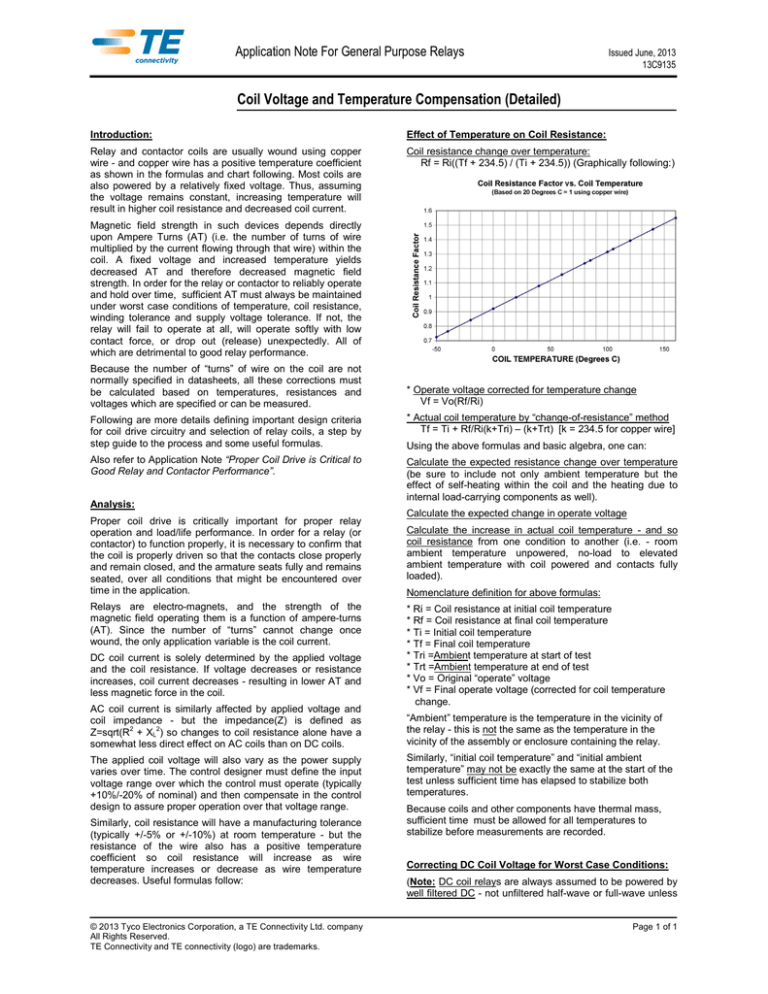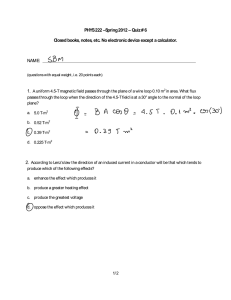
Application Note For General Purpose Relays
Issued June, 2013
13C9135
Coil Voltage and Temperature Compensation (Detailed)
Introduction:
Effect of Temperature on Coil Resistance:
Relay and contactor coils are usually wound using copper
wire - and copper wire has a positive temperature coefficient
as shown in the formulas and chart following. Most coils are
also powered by a relatively fixed voltage. Thus, assuming
the voltage remains constant, increasing temperature will
result in higher coil resistance and decreased coil current.
Coil resistance change over temperature:
Rf = Ri((Tf + 234.5) / (Ti + 234.5)) (Graphically following:)
Magnetic field strength in such devices depends directly
upon Ampere Turns (AT) (i.e. the number of turns of wire
multiplied by the current flowing through that wire) within the
coil. A fixed voltage and increased temperature yields
decreased AT and therefore decreased magnetic field
strength. In order for the relay or contactor to reliably operate
and hold over time, sufficient AT must always be maintained
under worst case conditions of temperature, coil resistance,
winding tolerance and supply voltage tolerance. If not, the
relay will fail to operate at all, will operate softly with low
contact force, or drop out (release) unexpectedly. All of
which are detrimental to good relay performance.
Because the number of “turns” of wire on the coil are not
normally specified in datasheets, all these corrections must
be calculated based on temperatures, resistances and
voltages which are specified or can be measured.
* Operate voltage corrected for temperature change
Vf = Vo(Rf/Ri)
Following are more details defining important design criteria
for coil drive circuitry and selection of relay coils, a step by
step guide to the process and some useful formulas.
* Actual coil temperature by “change-of-resistance” method
Tf = Ti + Rf/Ri(k+Tri) – (k+Trt) [k = 234.5 for copper wire]
Also refer to Application Note “Proper Coil Drive is Critical to
Good Relay and Contactor Performance”.
Calculate the expected resistance change over temperature
(be sure to include not only ambient temperature but the
effect of self-heating within the coil and the heating due to
internal load-carrying components as well).
Analysis:
Proper coil drive is critically important for proper relay
operation and load/life performance. In order for a relay (or
contactor) to function properly, it is necessary to confirm that
the coil is properly driven so that the contacts close properly
and remain closed, and the armature seats fully and remains
seated, over all conditions that might be encountered over
time in the application.
Relays are electro-magnets, and the strength of the
magnetic field operating them is a function of ampere-turns
(AT). Since the number of “turns” cannot change once
wound, the only application variable is the coil current.
DC coil current is solely determined by the applied voltage
and the coil resistance. If voltage decreases or resistance
increases, coil current decreases - resulting in lower AT and
less magnetic force in the coil.
AC coil current is similarly affected by applied voltage and
coil impedance - but the impedance(Z) is defined as
Z=sqrt(R2 + XL2) so changes to coil resistance alone have a
somewhat less direct effect on AC coils than on DC coils.
The applied coil voltage will also vary as the power supply
varies over time. The control designer must define the input
voltage range over which the control must operate (typically
+10%/-20% of nominal) and then compensate in the control
design to assure proper operation over that voltage range.
Similarly, coil resistance will have a manufacturing tolerance
(typically +/-5% or +/-10%) at room temperature - but the
resistance of the wire also has a positive temperature
coefficient so coil resistance will increase as wire
temperature increases or decrease as wire temperature
decreases. Useful formulas follow:
© 2013 Tyco Electronics Corporation, a TE Connectivity Ltd. company
All Rights Reserved.
TE Connectivity and TE connectivity (logo) are trademarks.
Using the above formulas and basic algebra, one can:
Calculate the expected change in operate voltage
Calculate the increase in actual coil temperature - and so
coil resistance from one condition to another (i.e. - room
ambient temperature unpowered, no-load to elevated
ambient temperature with coil powered and contacts fully
loaded).
Nomenclature definition for above formulas:
* Ri = Coil resistance at initial coil temperature
* Rf = Coil resistance at final coil temperature
* Ti = Initial coil temperature
* Tf = Final coil temperature
* Tri =Ambient temperature at start of test
* Trt =Ambient temperature at end of test
* Vo = Original “operate” voltage
* Vf = Final operate voltage (corrected for coil temperature
change.
“Ambient” temperature is the temperature in the vicinity of
the relay - this is not the same as the temperature in the
vicinity of the assembly or enclosure containing the relay.
Similarly, “initial coil temperature” and “initial ambient
temperature” may not be exactly the same at the start of the
test unless sufficient time has elapsed to stabilize both
temperatures.
Because coils and other components have thermal mass,
sufficient time must be allowed for all temperatures to
stabilize before measurements are recorded.
Correcting DC Coil Voltage for Worst Case Conditions:
(Note: DC coil relays are always assumed to be powered by
well filtered DC - not unfiltered half-wave or full-wave unless
Page 1 of 1
specifically noted. Furthermore, datasheet information, such
as coil resistance, is assumed to be specified at room
temperature (approx. 23°C unless otherwise noted).
Worst case relay operating conditions are at minimum
supply voltage and maximum coil resistance at the highest
operating ambient temperature under the highest contact
current loading.
The designer should then correct the input voltage to adjust
for the increased coil resistance and decreased AT so that,
worst case there is still enough AT to operate the relay and
fully seat the armature. This will ensure that full force is
applied on the contacts. If the contact is closed but the
armature not seated, the contact force will be low and so the
contact(s) will be subject to overheating and prone to tackwelding upon application of high currents.
Since the internal heating from the coil and from the load on
the contacts is not easily calculated, the most accurate way
to begin this calculation is to take a sample relay of the same
type and rated coil voltage and follow these steps:
• Measure the coil resistance “Ri” at room temperature and
record the room temperature parameters “Ti” and “Tri” for
later use.
• Load the contact to maximum current and apply nominal
voltage to the coil.
• Wait until the coil temperature has stabilized (i.e. until the
coil resistance has stopped changing) then measure the
“hot” coil resistance “Rf”. This will then tell how much
“temperature rise” occurred in the coil due to coil and
contact currents. Also measure any change in the ambient
temperature and record that as the “Trt” value for use
later.
• Next, add in the difference between room temperature and
the maximum expected ambient temperature to the loaded
coil resistance above. Using the “Rf” formula or the chart,
correct the “hot” coil resistance measured above for the
increased ambient temperature. This becomes the
corrected “Rf” value.
• Using the preceding formula “Vf = Vo(Rf/Ri)”, calculate the
new value for “Vf”, using the minimum operating voltage
provided in the datasheet. (i.e. nominal coil voltage minus
the negative tolerance on the minimum operate voltage
provided in the datasheet (usually 80% of nominal) for DC
coils).
• This gives the minimum voltage that must be applied to the
relay coil to provide proper operation under the worst
operating conditions.
Coil Voltage and Temperature Compensation (Detailed)
• Select a relay coil voltage that will work with this minimum
supply voltage provided or adjust the nominal power
supply voltage so that this minimum voltage (and therefore
minimum AT) is always provided.
• One must be careful to also subtract out and correct for
voltage drops in the coil circuit itself due to series diodes,
transistors (especially Darlington), etc. so that the
minimum required voltage actually applied to the coil
remains as calculated.
• Finally, repeat the temperature rise tests at maximum
ambient temperature to verify that the coil temperature at
the maximum allowable coil voltage, ambient temperature
and load current does not exceed the maximum
temperature allowed by the coil Insulation Temperature
Class. This varies slightly by the specific UL application
standard, but it is typically Class A =105°C, Class B =
130°C, Class F = 155°C and Class H = 180°C.
• Since the nominal coil voltage available does not always
exactly match the calculated value in the application, it
may be necessary to repeat the calculations above using
the actual parameters of the closest coil available.
AC Coil Correction:
• Note: AC coils are corrected similarly while remembering
that the resistance(R) change affects the AC coil
impedance by the formula Z=sqrt(R2 + XL2) rather than
linearly so that the effect on coil current, and thus AT, is
similarly non-linear. Reference TE Application Note
“Proper Coil Drive is Critical to Good Relay and Contactor
Performance” paragraph titled “Characteristics of AC Coil
Relays and Contactors”.
Conclusion:
Consult TE Product Engineering for assistance in the event
that an acceptable mix of applied voltage range and
available coil values is not compatible with the ambient
temperature range needed in the application.
Disclaimer:
TE has made every reasonable effort to confirm the
accuracy of the information set forth herein; however, TE
does not guarantee that it is error-free nor does TE make
any other representation, warranty, or guarantee that the
information is accurate, correct, reliable or current. TE
EXPRESSLY DISCLAIMS ALL WARRANTIES REGARDING
THE INFORMATION CONTAINED HEREIN, WHETHER
EXPRESS, IMPLIED OR STATUTORY, INCLUDING ANY
IMPLIED WARRANTIES OR MERCHANTABILITY OR
FITNESS FOR A PARTICULAR PURPOSE. In no event will
TE be liable for any direct, indirect, incidental, special or
consequential damages arising from or related to Recipient’s
use of the information.
Page 2 of 2



